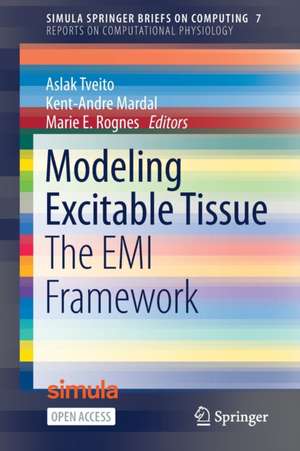Modeling Excitable Tissue: The EMI Framework: Simula SpringerBriefs on Computing, cartea 7
Editat de Aslak Tveito, Kent-Andre Mardal, Marie E. Rognesen Limba Engleză Paperback – 31 oct 2020
Preț: 344.75 lei
Nou
Puncte Express: 517
Preț estimativ în valută:
65.98€ • 71.64$ • 55.42£
65.98€ • 71.64$ • 55.42£
Carte tipărită la comandă
Livrare economică 22 aprilie-06 mai
Preluare comenzi: 021 569.72.76
Specificații
ISBN-13: 9783030611569
ISBN-10: 3030611566
Pagini: 100
Ilustrații: XVII, 100 p. 25 illus. in color.
Dimensiuni: 155 x 235 mm
Greutate: 0.18 kg
Ediția:1st ed. 2021
Editura: Springer International Publishing
Colecția Springer
Seriile Simula SpringerBriefs on Computing, Reports on Computational Physiology
Locul publicării:Cham, Switzerland
ISBN-10: 3030611566
Pagini: 100
Ilustrații: XVII, 100 p. 25 illus. in color.
Dimensiuni: 155 x 235 mm
Greutate: 0.18 kg
Ediția:1st ed. 2021
Editura: Springer International Publishing
Colecția Springer
Seriile Simula SpringerBriefs on Computing, Reports on Computational Physiology
Locul publicării:Cham, Switzerland
Cuprins
Derivation of a cell-based mathematical model of excitable cells.- A cell-based model for ionic electrodiffusion in excitable tissue.- Modeling cardiac mechanics on a subcellular scale.- Operator splitting and finite difference schemes for solving the EMI model.- Solving the EMI equations using finite element methods.- Iterative solvers for EMI models.- Improving neural simulations with the EMI model.- Index.
Notă biografică
Kent-Andre Mardal is a professor of mechanics at the University of Oslo and an adjunct research scientist at Simula Research Laboratory. He has published more than 90 scientific publications, including journal papers, two co-authored books and the co-edited the book about the FEniCS project, for which he was a core developer for many years. Research interests include computational modeling of various life science applications and robust, stable and accurate numerical schemes.
Marie E. Rognes is a research professor at Simula Research Laboratory and a founding member of the Young Academy of Norway. She has over 50 scientific publications and has delivered numerous keynote addresses and invited talks, including a TEDx talk. Her research is primarily focused on mathematical and computational modelling of fluid flow in the brain, and this work has been partially funded by an ERC starting grant.
Aslak Tveito is a professor of scientific computing at the University of Oslo,and the CEO of Simula Research Laboratory. He has co-authored three text books, one research monograph and many journal papers on computational physiology. His research interests are related to the use of computational methods to understand the dynamics of collections of excitable cells.
Aslak Tveito is a professor of scientific computing at the University of Oslo,and the CEO of Simula Research Laboratory. He has co-authored three text books, one research monograph and many journal papers on computational physiology. His research interests are related to the use of computational methods to understand the dynamics of collections of excitable cells.
Textul de pe ultima copertă
This open access volume presents a novel computational framework for understanding how collections of excitable cells work. The key approach in the text is to model excitable tissue by representing the individual cells constituting the tissue. This is in stark contrast to the common approach where homogenization is used to develop models where the cells are not explicitly present. The approach allows for very detailed analysis of small collections of excitable cells, but computational challenges limit the applicability in the presence of large collections of cells.
Caracteristici
This is a brief text that is accessible for a large audience with a background in computational mathematics The text introduces a state-of-the-art approach to simulation of excitable cells Software is available for all the models presented in the text














